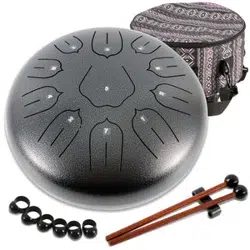Loading ...
Loading ...
Loading ...

www.PyleUSA.com
16
www.PyleUSA.com
17
Drum Care:
1. Avoid playing your Steel Tongue Drum extremely aggressively with the
mallets. This can cause the tongues to bend and experience “Metal
Fatigue” which can cause the tongues to fall out of tune. We suggest
gentle playing with the mallets, or using the hands/ngers/thumbs.
It is suggested that if you are attempting to play at comparable volumes
to other loud instruments that you mic your Steel Tongue Drum.
2. Your drum is very tough, but it is susceptible to scratches and dings if
rubbed against abrasive surfaces, or dropped.
3. Avoid exposing the drum to extremes in temperature.
For instance: Hot cars in the summer, snow, saunas.
Washing/Cleaning:
Your drum has been powder-coated, so it is relatively impermeable against
moisture. We suggest using a light touch-up of clear nail-polish to coat
scratches. Due to the nature of powder-coat used, the instrument cannot
be re-coated if it gets scratched. However, if you treat it well it will last you a
lifetime!
Troubleshooting:
1. I hear a rattle/buzz!
Please check to make sure that your wooden plug is axed rmly in your
instrument (It must be very snug to avoid buzzing). Make sure there is no
debris inside the drum/no debris stuck to the tongues. If it is still sounding
o please contact us.
2. There is rust forming at the base of the tongues!
We ne tune our instruments after they come out of the kiln by cutting
the tongues slightly longer. Although we re-coat these areas on the
drums with rust paint before they come to you, we may miss small areas.
Please take a ne sandpaper, give the area a light sanding and use a
desired metal paint to re-coat the area. Acetone free nail-polish will
remove paint without hurting the nish.
You and Me
